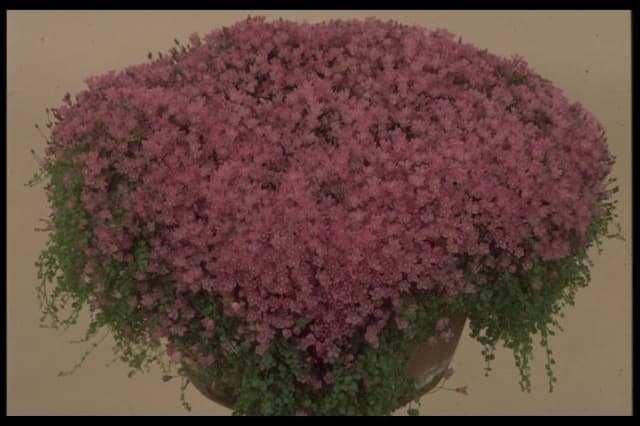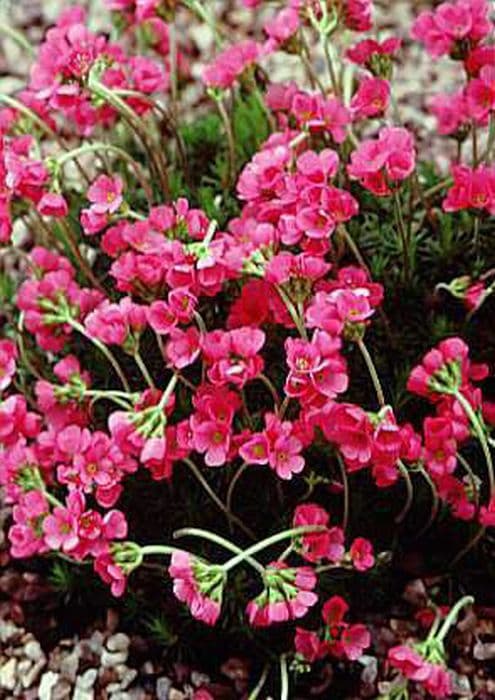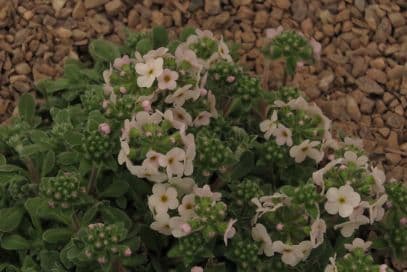Auricula Primula auricula 'Joy' (Au/a)

ABOUT
Primula auricula 'Joy', commonly known as auricula, is a captivating perennial plant favored for its striking appearance. This particular variety boasts ornate flowers which typically display a rich and vivid palette of colors often encompassing hues from bright yellows to deep purples. The flowers of 'Joy' possess a distinctive form, featuring a central cluster of tubular petals that create a mesmerizing eye-like pattern, surrounded by a ring of larger, more rounded petals. This bicolor effect adds to the allure of the auricula, with a captivating contrast that draws the eye. The foliage of the auricula 'Joy' is also deserving of admiration. The leaves are generally fleshy and oblong, exuding a subtle, natural sheen that may reflect sunlight, giving them a slightly glossy appearance. They tend to form a low rosette at the base of the plant, creating an appealing ground-hugging mat that showcases the floral display above. Throughout its blooming period, the auricula 'Joy' will present a remarkable variety of flowers, each contributing to a splendid array of color that energizes any garden space. The blooms are held aloft on sturdy stems that rise from the rosette of leaves, presenting the flowers in a manner that seems almost designed for admiration. The overall effect is a charming and distinctive plant that can add a touch of refined beauty to various garden settings, from rock gardens to alpine displays.
About this plant
 Names
NamesFamily
Primulaceae
Synonyms
Bear's Ear, Mountain Cowslip, Auricula, Auricula Primrose
Common names
Primula auricula 'Joy'
 Toxicity
ToxicityTo humans
Primula auricula, commonly known as auricula or bear's ear, does not have a high toxicity level for humans. However, it's worth noting that some individuals may experience mild irritation or contact dermatitis after handling the plant, particularly if they have sensitive skin. If ingested, it could potentially cause mild stomach upset, but serious poisoning is rare. Symptoms could potentially include nausea, vomiting, or diarrhea if consumed in significant quantities. It is always advisable to avoid eating ornamental plants due to these risks.
To pets
For pets, Primula auricula, known as auricula or bear's ear, can cause mild gastrointestinal upset if ingested. Although the plant is not considered highly toxic, pets can show symptoms like vomiting, diarrhea, or drooling. Some animals may also experience mild dermatitis if they come into contact with the sap of the plant. It is recommended to keep an eye on pets and prevent them from chewing on ornamental plants to avoid any potential discomfort or reactions.
 Characteristics
CharacteristicsLife cycle
Perennials
Foliage type
Evergreen
Color of leaves
Green
Flower color
Yellow
Height
6-12 inches (15-30 cm)
Spread
6-12 inches (15-30 cm)
Plant type
Herb
Hardiness zones
5
Native area
Europe
Benefits
 General Benefits
General Benefits- Aesthetic Appeal: Adds vibrant color and unique beauty to gardens with its bright flowers.
- Attracts Pollinators: Invites beneficial pollinators such as bees and butterflies to the garden.
- Easy to Grow: Known for being low-maintenance and suitable for novice gardeners.
- Compact Growth: Ideal for small spaces, borders, and rock gardens due to its tidy growth habit.
- Long Blooming Period: Offers a prolonged display of flowers, typically from mid to late spring.
- Diverse Cultivation: Can be grown in pots or containers as well as in-ground gardens.
- Propagation Potential: Can be easily propagated through offsets, increasing garden stock.
- Cultural Significance: Often used in floral displays and garden competitions, cherished for its unique appearance.
 Medical Properties
Medical PropertiesThis plant is not used for medical purposes.
 Air-purifying Qualities
Air-purifying QualitiesThis plant is not specifically known for air purifying qualities.
 Other Uses
Other Uses- The Auricula Theater is a unique garden feature in which the Primula auricula 'Joy' can be prominently displayed, following a tradition dating back to the 18th century where the plants were showcased on tiered stands for decoration and competition among enthusiasts.
- Primula auricula 'Joy' can be used in floral art due to its vivid colors and interesting form, providing a striking element in arrangements that require a small, eyecatching flower.
- The flowers can be crystallized and used for edible cake decorations, providing a unique and beautiful embellishement for desserts and pastries.
- These plants are often used in educational settings for teaching botany and horticulture, especially regarding breeding and hybridization practices due to their wide variety of colors and ease of propagation.
- Primula auricula 'Joy' can be used as part of sensory gardens due to its delicate fragrance, contributing to a garden experience that engages the sense of smell.
- It can be cultivated and sold as a collector's item, particularly among enthusiasts of alpine and rockery plants, who appreciate the rare and unique cultivars.
- The vibrant petals of Primula auricula 'Joy' can be used in crafts, such as pressed flower projects, where their color retains well when dried.
- The plant's compact size makes it an excellent choice for miniature gardens or fairy gardens, adding a whimsical touch with its small-scale floral presence.
- In photography, Primula auricula 'Joy' can provide a naturally colorful subject for macro photography due to its intricate patterns and bold colors.
- These plants can be used in living jewelry, like pendants or rings, with small containers or terrariums for a unique botanical accessory.
Interesting Facts
 Feng Shui
Feng ShuiThe Auricula is not used in Feng Shui practice.
 Zodiac Sign Compitability
Zodiac Sign CompitabilityThe Auricula is not used in astrology practice.
 Plant Symbolism
Plant Symbolism- Unique Beauty: The 'Joy' variety of Auricula, with its distinct pattern and vivid colors, suggests a celebration of uniqueness and the beauty of diversity.
- Patience: Auriculas are known for their growing habit, reminding us that patience brings rewards, much like the careful cultivation it takes to grow this plant.
- Benevolence: The generous blooming of the Auricula and the 'Joy' it brings to gardeners is often associated with kindness and the joy of giving to others.
- Overcoming Challenges: The Auricula's ability to thrive in alpine conditions symbolizes resilience and the capacity to overcome difficult circumstances.
- Friendship: Often shared among gardening enthusiasts, the Auricula represents the cultivation of lasting friendships and meaningful connections through common interests.
 Water
WaterWhen watering Bear's Ear, it is crucial not to overwater, as they prefer soil that is consistently moist but not waterlogged. Water the plant when the top inch of soil feels dry to the touch, which typically translates to once a week, depending on the environmental conditions. Use lukewarm water, and aim to water around the base of the plant, avoiding the foliage to prevent fungal issues. In terms of the amount, provide enough water to soak the soil, roughly up to 16 ounces, and allow excess water to drain away. During dormancy in winter, reduce watering frequency.
 Light
LightBear's Ear thrives best in bright, indirect light conditions. It should be placed in a location where it receives plenty of light but is protected from the harsh midday sun. An east or west-facing windowsill where the sun is not as intense would be an ideal spot for this plant.
 Temperature
TemperatureBear's Ear prefers cooler temperatures, thriving in an environment that ranges between 50°F to 70°F. It's important to keep the plant away from drafts and avoid extreme temperature changes. The maximum temperature should not exceed 80°F, and the minimum temperature this plant can tolerate is down to 40°F, making it sensitive to frost.
 Pruning
PruningPruning Bear's Ear is necessary to remove dead or dying leaves and encourage bushier growth. Trim back any spent flowers after blooming to encourage more flowers. The best time to prune is immediately after flowering has ceased. Pruning can be done as needed throughout the growing season, but you should avoid heavy pruning late in the fall.
 Cleaning
CleaningAs needed
 Soil
SoilAuricula Primrose requires well-draining, slightly alkaline soil with a pH of 6.5 to 7.5. A good mix can be created with equal parts of loam, peat moss, and sand to ensure good drainage and aeration. Adding perlite or grit can also improve drainage, essential for preventing root rot.
 Repotting
RepottingAuricula Primrose should be repotted once every 1 to 2 years. Repotting is best done in the late summer or early fall after flowering has finished. This schedule helps refresh the soil and allows the plant to accommodate root growth.
 Humidity & Misting
Humidity & MistingAuricula Primrose thrives in moderate humidity levels. Aim to keep the humidity around 50-60%; however, good air circulation is also crucial to prevent any mold or fungal issues due to excessive moisture.
 Suitable locations
Suitable locationsIndoor
Place in bright light, cool temps; avoid direct sun.
Outdoor
In partial shade, shelter from intense sun and heavy rain.
Hardiness zone
4-8 USDA
 Life cycle
Life cyclePrimula auricula 'Joy' (commonly known as Auricula) starts its life as a seed which, when sown, germinates in moist, well-drained soil, typically in cool to mild temperatures. Upon germination, seedlings emerge and develop a rosette of leaves at the base. As the plant matures, it forms a flower stalk that bears clusters of showy, often fragrant flowers, typically blooming in the spring. After pollination, which can be aided by insects or self-fertilization, the plant produces seed capsules that ripen and eventually release seeds for dissemination. Throughout the growing season, Auricula will produce offsets from the main rosette, which can be divided and transplanted to propagate the plant. After flowering, the plant goes dormant, especially in hot summer climates, but the evergreen foliage persists through winter, ready to start the cycle anew as temperatures warm.
 Propogation
PropogationPropogation time
Spring-Early Summer
Propogation: The most popular method of propagating the Primula auricula, commonly known as Auricula Primrose, is through division. This should ideally be carried out in late summer after the plant has finished flowering. To propagate by division, carefully lift the plant from the ground, ensuring minimal root disturbance. Gently tease apart the clumps into smaller sections, each with a portion of roots and at least one growing point. Replant these divisions into a well-draining soil mix, maintaining the same depth at which they were originally growing. Water-in the new plantings to settle the soil around the roots and keep the soil moist but not waterlogged to encourage establishment. This allows the divisions to develop a strong root system before the onset of winter.









